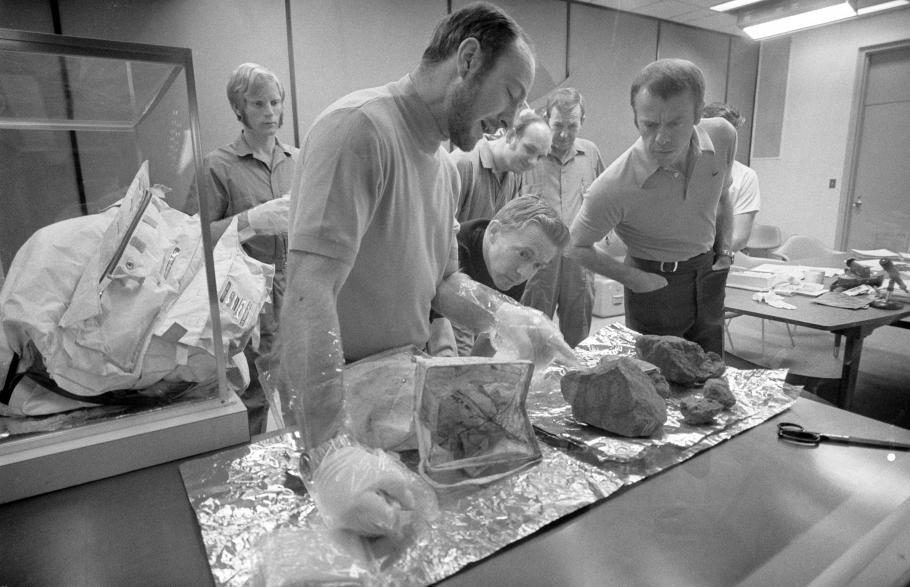On Thursday, February 4, the world lost the last of the Apollo 14 astronauts. Edgar Dean Mitchell, U.S. Navy test pilot and the sixth person to walk on the Moon, passed away in his sleep near his Florida home at the age of 85. Though it was his only flight into space, Apollo 14 provided the rather insightful Mitchell with an opportunity to test the bounds of the human mind in ways sometimes only he knew of at the time. Characterized later as the “Overview Effect,” he described the space travel experience as one that shifted his own beliefs about human existence, though having an openness to such a change was always a part of Mitchell’s way of life. In many respects, he could be considered the most unique human to walk on the Moon, having gone those 386,243 kilometers (240,000 miles) expecting a psychological and physical experience like no other, and returning satisfied in what he learned about himself.
Ed Mitchell, Stu Roosa, and Alan Shepard examine lunar samples in the Lunar Receiving Laboratory in Houston, February 18, 1971.
Mission commander Alan Shepard was the consummate test pilot and astronaut: Our country’s first person in space had a big, brash personality, was a supposed ladies’ man, and spent years in charge in the Astronaut Office. His second and last spaceflight was highlighted by a golf shot with an improvised club he said went “miles and miles.” The quieter command module (CM) pilot, Stuart Roosa, started his professional life as a smokejumper in Colorado but was said to have thoroughly enjoyed his hours of quiet as his crewmates explored the Fra Mauro Highlands. Roosa, entirely at odds with Mitchell’s perspective, said space made no change to who he was. The odd duck of the group was certainly Mitchell, who at the time was already interested in UFOs, research on human consciousness and other phenomena, and ESP. He even attempted to conduct a few telepathy experiments during the trans-Earth portion of his mission, never telling his crewmates until the media carried the story after the flight. That was certainly atypical of an astronaut, and Shepard apparently did not appreciate being kept in the dark. Mitchell spoke often in the last few decades of the effect seeing Earth and being in space had on his psyche. Here at the Museum, as we prepare for new exhibitions and at least one that addresses the astronaut view of Earth from space, his experience has come up in conversation and I regret we will not have the opportunity to talk to him directly about that. As a young curator here, I had little opportunity to interact with Captain Mitchell, and I was not even alive when he walked on the Moon. He never spoke at a lecture here or attended a program. As our curator for astronaut cameras, however, he and I did overlap. As an observer of space artifact auctions, his attempt to sell a J.A. Maurer 16mm camera used in the Apollo 14 lunar module (LM) to film surface activities was noteworthy to say the least. With only the LM Maurer from Apollo 12 in the collection because it was returned for having malfunctioned, I had assumed the other five missions left their movie cameras behind. NASA’s pursuit of the camera over the next few years resulted in our acquisition of it in 2012. This sale and a few others created a groundswell of political support for a law that allows early astronauts to retain such memorabilia, which was signed by President Obama later in 2012. My only word from Mitchell about the camera came months later in an email passed to me, his personal reflections on returning the camera from the Moon. According to him, in the rush to transfer equipment from the LM to CM, he grabbed the camera unit as a whole, not stopping to remove the film magazine as originally planned in order to save time. Taking it home after the mission as a keepsake, Mitchell held onto it for 40 years, and this Museum will diligently and proudly maintain it on his behalf for many decades to come. Shepard and Mitchell explored where Apollo 13 was meant to visit. They spent little time photographing each other on the surface. They were the last crew not to enjoy the luxury of a lunar rover to travel and explore the Moon. And the crew was the last to endure quarantine when they returned from their journey. Mitchell and his crewmates trained hard, worked hard, and sacrificed family time to achieve what so few can even imagine today. We salute their efforts to enrich our knowledge of the Moon, and I thank Captain Mitchell for his service to our country and his open-minded perspective and encouragement for all of us to see ourselves as part of a larger, interconnected world.
Astronauts Alan Shepard, Stu Roosa, and Ed Mitchell (from left to right) stand amongst their families and talk to a gathered crowd at the Johnson Space Center, 26 February 1971.

